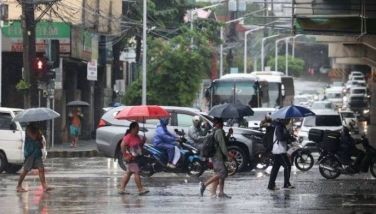Philippine population hits 100.98 M
MANILA, Philippines - The country’s population increased further to 100.98 million in 2015, higher by 8.64 million than in 2010 when the national census was last conducted, the Philippine Statistics Authority (PSA) reported yesterday.
Based on the Census of Population (POPCEN) concluded in August last year, the country’s population rose at a rate of 1.72 percent from 2010 to 2015.
Out of the country’s 18 administrative regions, Region IV-A, comprising the provinces of Cavite, Laguna, Rizal and Quezon, had the biggest population of 14.41 million in 2015.
This was followed by the National Capital Region (NCR) or Metro Manila with 12.88 million and Central Luzon with 11.22 million. The combined population of these regions accounted for 38.1 percent of the total last year.
Out of the country’s 81 provinces, Cavite was the most populous with 3.68 million, followed by Bulacan (3.29 million) and Laguna (3.04 million).
Twenty-seven other provinces surpassed the one- million population mark. These are Cavite, Bulacan, Laguna, Pangasinan, Cebu, Rizal, Batangas, Negros Occidental, Pampanga, Nueva Ecija, Camarines Sur, Iloilo, Quezon, Leyte, Isabela, Bukidnon, North Cotabato, Tarlac, Negros Oriental, Albay, Bohol, Cagayan, Maguindanao, Lanao del Sur, Davao del Norte, Zamboanga del Norte and Zamboanga del Sur.
Batanes had the smallest population with 17,246 persons. Two other provinces posted a population size of less than 100,000. These are Siquijor with 95,984 and Camiguin with 88,478.
Although currently not the most populous region, the Autonomous Region in Muslim Mindanao (ARMM) had the fastest population growth rate of 2.89 percent during the census period.
Out of the country’s 33 highly urbanized cities, four had surpassed the one-million population mark, namely, Quezon City with 2.94 million, Manila (1.78 million), Davao City (1.63 million) and Caloocan City (1.58 million).
The POPCEN 2015 was undertaken by the PSA in August 2015 under Republic Act No. 10625 (Philippine Statistical Act of 2013) and Executive Order No. 352.
The PSA census came following a report of the United Nations saying the urban population of developing countries is projected to double by 2030.
While cities have emerged over the past 20 years as the world’s economic platforms for production and innovation, helping millions escape poverty through better jobs and improved quality of life, the inaugural edition of the World Cities Report, compiled by the UN Human Settlements Program (UN-HABITAT), said mass urbanization has also led to overcrowding, deepened inequalities and triggered a raft of environmental and health challenges. – With Pia Lee-Brago
- Latest
- Trending































